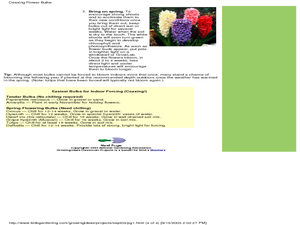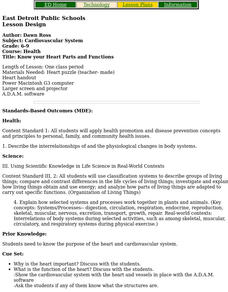Curated OER
Vegetation Scavenger Hunt
Students use picture cards to familiarize themselves with plant structures and characteristics. They collect plant specimens without destroying the plant and mount them creating a class herbarium.
Curated OER
Coaxing Flower Bulbs
Students complete an experiment for coaxing flower bulbs into growth. In this flower growth instructional activity, students research various types of flower bulbs that may be used to complete a coaxing experiment. Students then complete...
Curated OER
Introduction to Plant Reproduction
Eight objectives pertaining to plant reproduction are stated and addressed in this presentation. Objectives include defining sexual and asexual reproduction, comparing monocots to dicots, explaining flower types, and more. Some of the...
Curated OER
Parts of a Plant
Children explore the parts of a plant (flower, seeds, stem, leaves, and roots) using a dandelion as an example.
Curated OER
PLANT PARTS WE EAT
Students identify an assortment of vegetables and learn how to locate the parts humans use for food. Students identify the plant parts we eat. Students color the pictures on their worksheets as provided. Students match the plants to the...
Curated OER
Classifying Monocot And Dicot Plants
Sixth graders identify the parts of a flower, and tell the difference between monocots and dicots. They group plant by leaf types and characteristics placing the information in table form on the computer.
Curated OER
Sun Seeking Plants
Pupils investigate the story "The Tiny Seed" by Eric Carle. This story is used to introduce the children to the concept that seeds change and grow into plants when conditions in the environment including temperature, light, water and...
Curated OER
Plants Vocabulary Quiz
In this plant vocabulary instructional activity, students draw lines to match 10 plant words with their meanings. Prior knowledge is assumed.
Curated OER
Co-evolution of Plants and Pollinators
High schoolers, while studying the rolls of pollinators and plants, explore co-evolution of mutualistic relationships.
Curated OER
Plants Letter Shapes
In this plant activity, students write plant vocabulary words into word shapes after reading their definitions. Students write 8 plant vocabulary words.
Curated OER
Hopi Culture: Parts of the Corn
Young scholars identify the parts of the corn stalk in English and Hopi. They discuss the significance of corn to the Hopi culture, and examine a diagram of the corn stalk. They discuss the purposes of the parts of the corn stalk, then...
Curated OER
Ecosystems - Plants and Animals Together
Students study the biotic and abiotic factors of an environment. In this exploratory lesson students examine the different trophic levels and how organisms are connected.
Curated OER
COMPARE SOILS BY GROWING PLANTS
The student will identify the difference in the rate of plant growth in three soils that vary in organic matter.1. Obtain three to four flowerpots, different types of soil, a record chart, three to five beans for each pot, and water....
Curated OER
Reproduction in Flowering Plants
In this flowering plants learning exercise, students review 11 vocabulary words associated with reproduction in flowering plants by matching the term with its definition.
Curated OER
Whose Parts Do I Have? (Wings and Things)
Pupils identify an animal and a body part and then matches a body part to a specific animal. This will assess their ability to sort organisms and objects into groups according to their parts and describe how the groups are formed and...
Curated OER
Know your Heart Parts and Functions
Students put together a 3-D interactive "heart" puzzle and learn the names of heart parts.
Curated OER
What Are the Parts of a Plant?
In this plant parts worksheet, students will fill in the blank of 4 statements about the function of the roots, stems, and leaves.
Curated OER
Plants -- What Are Their Parts and Functions?
Students identify the parts of a flowering plant and their functions. They describe its life cycle as well. They compare the parts of the plant to the roles that are needed in a democracy.
Curated OER
Plants
In this science activity, students investigate plants by first reading a paragraph of information. Students then choose a plant, illustrate and write about it.
Curated OER
People and Plants
Students examine the uses of plants from many different biomes, particularly, rain forests to uncover data about the production of new drugs and the cross-cultural sharing of foods. A rain forest food festival reinforces the concept of...
Curated OER
What Do Plants Need to Grow?
Students in an ESL classroom identify the necessary requirements plants need to grow. Using Spanish worksheets, they label each part of a plant and state their function. They are given cutouts of a picture and the Spanish word in which...
Curated OER
Plants
Students plant bean seeds and draw pictures of the plants as they grow. They create their own garden, plant the seeds, and keep a journal of their growth.
Curated OER
Can Fun Gus Help Plants/Trees Grow?
Students participate in an experiment in which they test the growth of different types of plants. They discover how growth rates vary using inoculum. They draw pictures and are read books about plants to end the instructional activity.
Curated OER
Wacky Weed Parts
Students view picture of weed and identify roots, stems, flowers, leaves, and seeds, describe function of each different weed part, and discuss how different parts of weed work together to benefit plant in its new environment.
Other popular searches
- Identifying Parts of Plants
- Parts of Plants Video
- Parts of Plants Organizer
- Reproductive Parts of Plants
- Parts of Plants Cell
- Comparing Parts of Plants
- Plants Parts
- Parts of Plants Mnemonic
- Edible Parts of Plants
- Comparing Plants Plant Parts
- Plants and Their Parts
- Plants Parts for Food

























